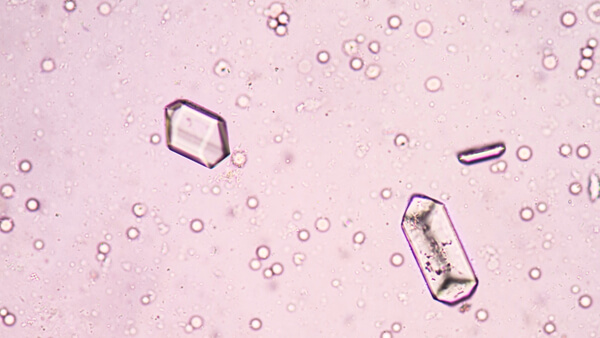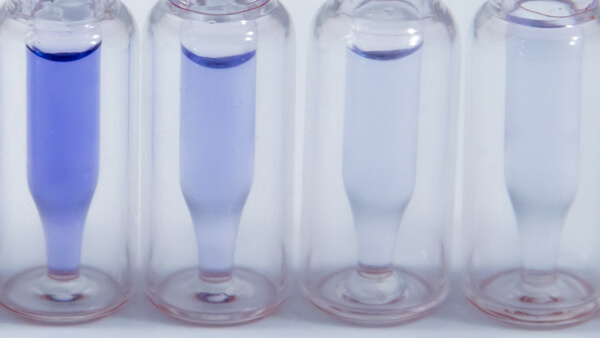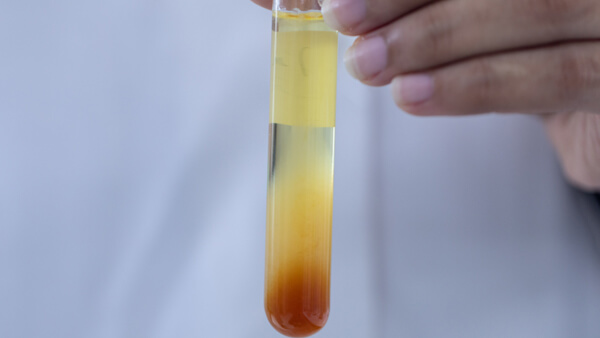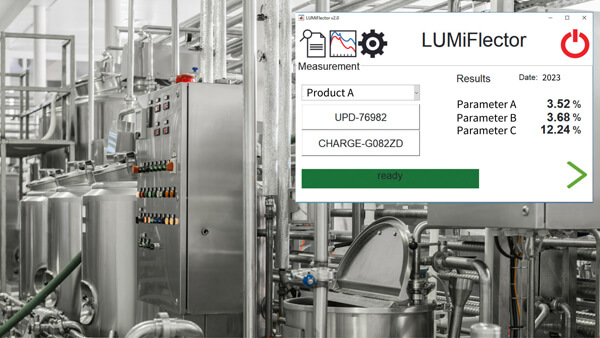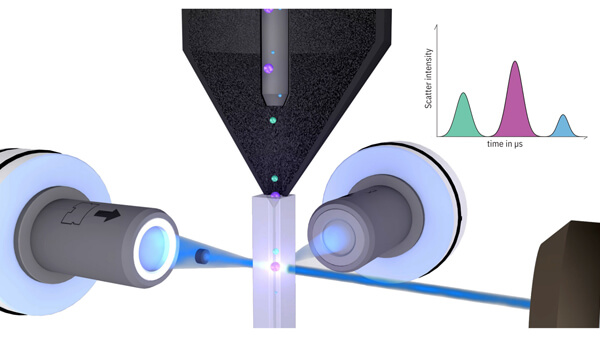- Home
- Application areas
- Sectors
- News
- About LUM
- Career
- Press releases
- Press reviews
- LUM Live
- Service
- Publications
- Contact
Type of Analysis
Which material characteristics do you wish to analyze?
Analysis type
Particle size distributions and Particle separation velocity distributions
1) Particle separation velocity distributions for the quality control of complex products
Quality control is the essential part for producing satisfying products. This relates to the control of the raw materials, intermediate and final products. For dispersion related products there may be changes in particle size of a single component, of the whole system or in material composition, which would affect the quality of the final product.
Therefore, an integral method measuring changes in size and density or rather their distribution has advantages over determining particle size distribution only. Particle velocity distributions are experimentally measured based on the primary principle with no assumptions
regarding dispersions properties, models or algorithms.
Particle velocity distributions are determined at earth gravity by LUMiReader® PSA and at higher gravity by LUMiSizer®.
2) Extinction-weighted size distribution
Particle velocity distributions are experimentally measured based on the primary principle with no assumptions regarding dispersions properties, models or algorithms.
Experimentally determined velocities can be transformed to a particle size distribution for gravity sedimentation and for centrifugal sedimentation based on respectively (ISO 13317-1:2001), (ISO 13318-1:2001 & ISO 13318-2:2007-09).
The result is the Stokes diameter of a settling particle, more precisely an equivalent spherical Stokes diameter. If the particle shape is known, such a shape influence may be accounted for by introducing corresponding shape factors into the basic Stokes’ law.
In principle, particle size determination is merely a transformation of the calculated particle velocity distribution data. There is no change in the distribution pattern or modality.
Extinction-weighted size distributions are determined by LUMiReader® PSA and by LUMiSizer®.
3) Volume-weighted size distribution
Extinction-weighted particle size distribution does not account for the optical properties of the dispersion. Thus, the different particle classes contributing to the total recorded extinction intensity are not correctly weighted.
To measure the correct amount of particles, present in defined size distribution classes, the differences in the refractive index between particles and continuous phase, and the geometrical particle shape have to be accounted for.
Volume-weighted size distributions are determined by LUMiReader® PSA and by LUMiSizer®.
4) LUMiSpoc® is working according to ISO 21501-2:2019
Determination of particle size distribution — Single particle light interaction methods — Part 2: Light scattering liquid-borne particle counter.
Analysis type
Particle Concentration / Particle Count
Fast and precise counting and sizing of every nano- and micro-particle in suspensions and emulsions. The new LUMiSpoc® quantifies the size distribution of dispersed mono- & very polydisperse particles and counts the concentration of the particle classes by the innovative single particle light scattering (SPLS) technology. The highly advanced LUMiSpoc® measures simultaneously fore- & sideward light scattering, features an unparalleled resolution & dynamic range, minor dilution factors and a very short measurement time.
Analysis type
Emulsion & suspension & foam analysis
LUM measuring devices are used for the direct physical characterization of separation, stability, destabilization, etc. of emulsions, suspensions, suspoemulsions and foams in their original concentration using different technologies, at different constant temperatures or with temperature ramps. In real time or directly physically accelerated. This characterizes formulations, semi-finished products and products in the state in which they are manufactured, further processed, stored, applied or consumed.
Analysis type
Shelf Life
ISO/TR 13097:2013
Guidelines for the characterization of dispersion stability
5 Prediction of the shelf life of a dispersion
5.1 General comments
“Shelf life is defined as the lifetime of a product (food, medicine, inks, cosmetics, etc.) during which there are no changes or variations greater than allowed by the product specification, meaning that the product is sufficiently stable and any destabilization phenomena that naturally occur are within tolerable limits. Strictly speaking, shelf life is not only related to the storage time (shelf time), but covers the total life span, from the production, storage, distribution, to the end of usage period with the end-user. It can be that for a given part of the shelf life, certain conditions (e.g. temperature) are expected to be met. There is no all-purpose method to calculate or predict shelf life of a dispersion. However by using appropriate techniques (see Clause 4) it is possible to analyse the time course of alteration of the dispersion state and to predict, in many cases, shelf life by data comparison or extrapolation.”
(Source: https://www.iso.org/standard/52802.html)
LUM instruments are used for the comparative and predictive analysis as described in ISO/TR 13097 chapter 5.2 and 5.3 and as referred in ISO/TR 18811.
Analysis type
Determination of adhesive strength and adhesive force
Adhesive bonding is used in a wide field of industries and offers many advantages. The increasing usage as joining technology also raises the need for quick testing procedures of bonded joint properties. Beside joining different material classes and providing stress distributions over entire bonding areas, it is possible to include additional functions in the bond lines, e.g. electric conductivity by metal particle inclusion. Besides the possibility of joining different material classes and providing a stress distribution over the entire bonding area, other objectives such as electric conductivity or sealing purposes can also be investigated. Increased usage also raises the need for quick testing procedures of bonded joint properties. Surface conditions significantly influence properties of many products and can be altered by coatings. In addition to strength determination of adhesive bonded joints, the adhesion of coating systems on various substrates is an important application area.
CAT (Centrifugal Adhesion Testing)-Technology in LUMiFrac® provides the possibility to test multiple samples simultaneously under respective identical testing conditions, whereby testing duration is decreased.
Analysis type
Determination & monitoring of product and process parameters
Monitoring of product compositions is essential for the control of unit processes. Nowadays, it is given a clear preference to in-line solutions. Product quality parameters have to be observed in almost real-time and the sensor should be used for different applications. LUM supplies with the Multi-Reflectance-Spectroscopy (MRS) an innovative technique based on multiwavelength reflectometry for in-situ quality/process control of suspensions and emulsions. This technology is fast, has no direct contact to the sample and is applicable without any chemicals and sampling.
Analysis type
Single particle counting
Particle size, size distribution and particle count are major characteristics in the field of particle technology. Contamination analysis and classification of nanomaterials according 2011/696/EU require precise data of the number-based particle size distribution and particle concentration.
LUM GmbH provides you with the measuring instrument LUMiSpoc®, developed by LUM GmbH and designed by the world-famous designer Luigi Colani. The LUMiSpoc® is a highly advanced single particle scattered light photometer that measures particle size distribution and particle concentration of nano- and microparticles in suspensions and emulsions with an unparalleled resolution and a dynamic range from below 100 nm to a few micrometers.
Powered by SPLS-Technology® (Single Particle Light-Scattering) the LUMiSpoc® records light scattered into different directions from individual nano- and micro particles passing a focused laser beam of non-spherical cross-section. Particle separation is achieved by hydrodynamic focusing of sample flow. Volume calibrated sample flow allows for accurate measurement of particle concentration.
The LUMiSpoc® analyses multimodal and very broad dispersed real-world particles and determines smallest size differences down to the nanometer range.
The areas of application of single particle counting include nanoparticle research, interdisciplinary particle analysis, filter and membrane testing, the production of pharmaceutical products such as vaccines, and the production of semiconductors, batteries and energy storage materials.
Individual advice is important to us
We will be happy to advise you on our equipment, processes and technologies.
LUM News
Jobs, Reports & Events
Fairs
European Coatings Show 2025 - LUM exhibiting at booth 4-640
Read more … European Coatings Show 2025 - LUM exhibiting at booth 4-640
